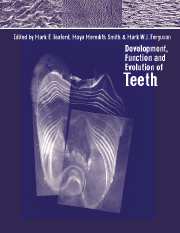Book contents
- Frontmatter
- Contents
- List of contributors
- Acknowledgements
- Part one Genes, molecules and tooth initiation
- Part two Tooth tissues: development and evolution
- 5 Evolutionary origins of dentine in the fossil record of early vertebrates: diversity, development and function
- 6 Pulpo-dentinal interactions in development and repair of dentine
- 7 Prismless enamel in amniotes: terminology, function, and evolution
- 8 Two different strategies in enamel differentiation: Marsupialia versus Eutheria
- 9 Incremental markings in enamel and dentine: what they can tell us about the way teeth grow
- Part three Evolution of tooth shape and dentition
- Part four Macrostructure and function
- Index
8 - Two different strategies in enamel differentiation: Marsupialia versus Eutheria
Published online by Cambridge University Press: 11 September 2009
- Frontmatter
- Contents
- List of contributors
- Acknowledgements
- Part one Genes, molecules and tooth initiation
- Part two Tooth tissues: development and evolution
- 5 Evolutionary origins of dentine in the fossil record of early vertebrates: diversity, development and function
- 6 Pulpo-dentinal interactions in development and repair of dentine
- 7 Prismless enamel in amniotes: terminology, function, and evolution
- 8 Two different strategies in enamel differentiation: Marsupialia versus Eutheria
- 9 Incremental markings in enamel and dentine: what they can tell us about the way teeth grow
- Part three Evolution of tooth shape and dentition
- Part four Macrostructure and function
- Index
Summary
Introduction
Tooth morphology is one of the most important tools for the identification of fossil mammals. It is not only the outer morphology which bears important information about the phylogeny and biomechanics of ancient animals, but the microstructure of the enamel itself that is also full of information. Using enamel structure only, it is almost impossible to identify taxa at the species level or to reconstruct the specific diet of an animal. Nevertheless, enamel microstructure can be used for more general inferences about biomechanics and phylogeny.
Knowledge of the complex enamel microstructure of mammalian teeth has increased dramatically during recent decades. A hierarchical system of levels of complexity was established (Koenigswald and Clemens, 1992) to facilitate the comparison and correlation of results (Table 8.1). The lowest level of complexity is the crystallite level, followed by the prism level, and the enamel type level. Enamel types are defined by the orientation of enamel prisms. Since several enamel types may form the enamel cap of a tooth, the schmelzmuster level focuses on the three-dimensional arrangement of these enamel types. The highest level of complexity is the dentition level, since different teeth may have different schmelzmusters, especially when they differ distinctly in morphology.
Two stratigraphically separated phases of enamel differentiation can be distinguished in the fossil record (Figure 8.1). During the first phase, prisms became separated from the interprismatic matrix and thus formed the prismatic enamel characteristic of most mammals. This development occurred during the Late Triassic and the Jurassic, and it is most probable that it occurred independently in the various lineages of Mesozoic mammals (Clemens, 1997; Sander, 1997; Wood and Stern, 1997).
- Type
- Chapter
- Information
- Development, Function and Evolution of Teeth , pp. 107 - 118Publisher: Cambridge University PressPrint publication year: 2000
- 13
- Cited by



